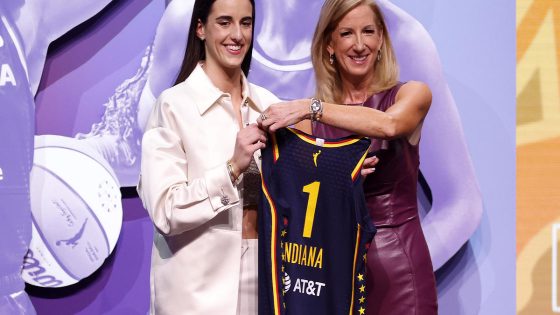College basketball sensation Caitlin Clark will earn less than six figures in her rookie season with the Indiana Fever, reigniting debate over whether professional women athletes in the U.S. are fairly paid.
Clark, this year’s No. 1 draft pick in the WNBA, will have a starting salary of $76,535 and earn roughly $338,000 over the four-year contract she signed with the Fever. The second, third and fourth picks in this year’s draft will also earn $76,535 their first year, according to the league’s collective bargaining agreement. The base annual pay for all four athletes will see only a modest rise over the next few years — $78,066 in 2025, $85,873 in 2026 and $97,582 in 2027.
Lower-ranked WNBA draft picks earn less, according to a wage scale outlined in the players’ agreement with the league. Players are also eligible for bonuses at the end of the season, based on performance. For example, the “Rookie of the Year” award comes with a $5,150 bonus.
The WNBA did not immediately respond to CBS MoneyWatch’s request for comment on how it sets athlete salaries.
Clark’s earnings are not limited to her WNBA salary. She’s expected to sign sponsorship deals that will likely lead to her earning far more than than the five figures she’ll get for playing basketball. Already, her name image and likeness is valued at $3 million, a figure that’s expected to grow, while she has already done TV commercials for advertisers including Gatorade, State Farm and Nike.
Still, Clark’s base pay pales in comparison to her counterparts in the NBA. Rookie Victor Wembanyama, the first pick in last year’s NBA draft, made more than $12 million for the 2023-24 season, his first year in the NBA, according to Spotrac, a site tracking sports statistics.Her salary is roughly equivalent to that of a first-year or junior New York-based attorney at a national law firm, according to a posting on job site Indeed.
With some online commentators expressing surprise at Clark’s pay, President Biden weighed in Tuesday on the issue of pay disparity in sports.
“Women in sports continue to push new boundaries and inspire us all. But right now we’re seeing that even if you’re the best, women are not paid their fair share,” he said in a post on X (formerly known as Twitter). “It’s time that we give our daughters the same opportunities as our sons and ensure women are paid what they deserve.”
To be sure, what female athletes “deserve” is up for debate. The NBA was founded decades ago and generates billions of dollars annually. The WNBA, by contrast, was launched in 1996 and is far smaller, generating an estimated $200 million in revenue annually, according to a report from Just Women’s Sports.
On the issue of compensation for individual players, “There isn’t an endless reservoir of money they get to deal with,” Greg Bouris, a professor sports management at Adelphi University, told CBS MoneyWatch, adding that the WNBA needs to meaningfully grow its revenue in order for player salaries to increase. “It comes down to economics.”
And as big of a star as Clark has been for college basketball, she remains untested in the professional arena, he noted. That’s part of the reason why both the NBA and WNBA issue caps on rookie salaries.
“They are coming in to play against the best basketball players in the world and they have yet to prove themselves,” Bouris said. “Sucess at one level doesn’t guarantee success at the other.”
By the same token, Clark is expected to add considerable sizzle to the league, as she did in helping the women’s NCAA tournament draw a larger TV audience than the men.
“She’s going to raise all boats”
“She’s coming in with all of this momentum in earned media coverage for the WNBA, so the league has an opportunity to capitalize on that. She’s having a tremendous economic impact,” Bouris said. “She’s going to raise all boats.”
The Women’s Sports Foundation, an advocacy group for women in sports founded by tennis legend Billie Jean King, has pointed to the relatively low pay in the WNBA as a reason why top players often compete overseas during the U.S. league’s off season to supplement their salaries. That includes WNBA star Brittney Griner, who was jailed in Russia while playing there and who previously noted in an interview that “the whole reason a lot of us go over is the pay gap.”
The WNBA has made strides in promoting pay equity in recent years. While NBA players collectively receive roughly 50% of the league’s revenue, WNBA players previously took home less than 23%. But that figure jumped to 50% under the latest labor deal with the league.
Yet the pay gap in professional basketball and most other sports remains, with only female tennis players achieving a measure of equity. In the NBA, the minimum rookie salary for the 2022-23 season was $953,000, according to Spotrac.
Ketra Armstrong, a professor of sports management at Michigan University said that while she views Clark as underpaid relative to their skills, so are many WNBA athletes.
“It’s a structural issue, and you can’t look at salaries in isolation or compare them to how much the men make because there are stark differences there,” Armstrong told CBS MoneyWatch in noting the enormous revenues the NBA generates, compared with the WNBA.
The upshot: For WNBA players’ salaries to increase, the league will have to land bigger broadcast deals, secure more lucrative corporate sponsorships, and sell more tickets and merchandise. But Armstrong identified the current moment as a potential turning point for the league.
“The Caitlin Clark impact is real. There is an energy and vibrance touching the WNBA in ways it never has before,” she said. “If we can get a groundswell increase in ticket sales for all WNBA teams, more merchandise sales, more media exposure, and more people investing, we’ll start to see movement in revenue.”
Source Agencies



